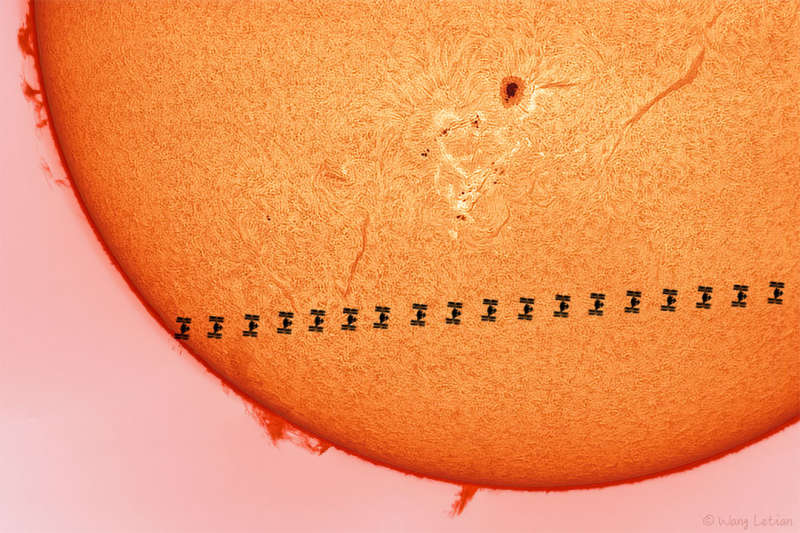Credit & Copyright: Wang Letian
(Eyes at Night)
Explanation:
Typically, the International Space Station is visible only at night.
Slowly drifting across the night sky as it orbits the Earth, the
International Space Station (ISS) can be seen as a
bright spot several times a year from many locations.
The ISS
is then visible only just after sunset or just before
sunrise because it shines by reflected sunlight --
once the ISS enters the Earth's shadow, it will drop out of sight.
The only occasion when the
ISS is visible during the day is when it
passes right in front of the Sun.
Then, it passes so quickly that only cameras
taking short exposures can visually freeze the
ISS's silhouette onto the background
Sun.
The featured picture did exactly that --
it is actually a series of images taken earlier this month from
Beijing,
China with perfect timing.
This image series was later combined with separate images
taken at nearly the same time but highlighting the
texture and activity on the busy
Sun.
The solar activity included numerous gaseous
prominences seen around the edge, highlighted in red,
filaments seen against the Sun's face, and a dark
sunspot.
1999 2000 2001 2002 2003 2004 2005 2006 2007 2008 2009 2010 2011 2012 2013 2014 2015 2016 2017 2018 2019 2020 2021 2022 2023 2024 2025 |
Yanvar' Fevral' Mart Aprel' Mai Iyun' Iyul' Avgust Sentyabr' Oktyabr' Noyabr' Dekabr' |
NASA Web Site Statements, Warnings, and Disclaimers
NASA Official: Jay Norris. Specific rights apply.
A service of: LHEA at NASA / GSFC
& Michigan Tech. U.
|
Publikacii s klyuchevymi slovami:
ISS - Sun - Mezhdunarodnaya kosmicheskaya stanciya - Solnce
Publikacii so slovami: ISS - Sun - Mezhdunarodnaya kosmicheskaya stanciya - Solnce | |
Sm. takzhe:
Vse publikacii na tu zhe temu >> | |
